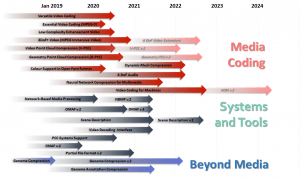MPEG has developed standards that are used daily by billions of people. A non exhaustive list includes MP3, Advanced Audio Coding (AAC), MPEG-2 Systems and Video, Advanced Video Coding (AVC), MP4 File Format, DASH. Other MPEG standards were widely used in the past but their use is gradually fading out, such MPEG-1 Video, and MPEG-1 Audio Layer 2.
This because MPEG is always ready to exploit the latest technology innovations to create new standards that offer new advantages because they outperform previous generations.
At the San Diego, CA meeting JVET, a joint MPEG (ISO) and VCEG (ITU) working goup tasked with the development of a new video compression standard, received 46 proposals from 32 organisations in response to the Call for Proposals issued in October 2017.
The target of the new standard is to achieve a compression ratio leading to a bitrate reduction of at least 50% that of HEVC, including High Dynamic Range (HDR), in addition to providing native support to such emerging applications as 360° omni-directional video.
I am really so proud to say that the tests showed that several proposals in many instances already exceeded 40% bitrate reduction compared to HEVC. Considering the technology power of the MPEG machine and that there are 30 months to the expected time of approval of the new standard (October 2020), there is no doubt that Versatile Video Coding (VVC), the name of the new video coding standard, will reach and probably exceed the target.
MPEG is always working to provide new abd better benefits for more humans on the Earth. In the case of VVC, those still disadvantaged in delivery infrastructure will be able to access services from which they were excluded so far. Others will be able to enjoy more involving experiences.
Of course this will only happen if mindless industry elements will not blow the opportunity again.
Posts in this thread (in bold this post)
- The MPEG ecosystem
- Why is MPEG successful?
- The life of an MPEG standard
- Genome is digital, and can be compressed
- Compression standards and quality go hand in hand
- Digging deeper in the MPEG work
- MPEG communicates
- How does MPEG actually work?
- Life inside MPEG
- Data Compression Technologies – A FAQ
- It worked twice and will work again
- Compression standards for the data industries
- 30 years of MPEG, and counting?
- The MPEG machine is ready to start (again)
- IP counting or revenue counting?
- Business model based ISO/IEC standards
- Can MPEG overcome its Video “crisis”?
- A crisis, the causes and a solution
- Compression – the technology for the digital age
- On my Charles F. Jenkins Lifetime Achievement Award
- Standards for the present and the future

